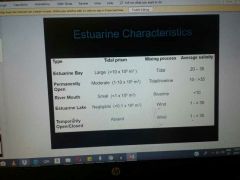![]()
![]()
![]()
Use LEFT and RIGHT arrow keys to navigate between flashcards;
Use UP and DOWN arrow keys to flip the card;
H to show hint;
A reads text to speech;
16 Cards in this Set
- Front
- Back
- 3rd side (hint)
|
How are estuarine thouht to be formed? |
By Glaciations, retreat of ice sheet after glaciation caused rapid elevation of sea level, flooding the continental shelf and resulting in inundation of river valleys. |
|
|
|
Characterisation of etuaries |
Drowned river valleys where riverine water meets the sea. Bi-directional flow. Less saline upstream more saline downstream. |
|
|
|
What is an estuarine system |
A coastal indentation that has a restricted connection to the ocean and remains open at least ntermittently. |
|
|
|
Name and describe the three regions of an estuarine system |
Tidal river zone - fluvial zone lacking ocean salinity but influenced by tidal rise and fall of sea level. Mixing zone - region withwatermass mixing and strong physical, chemical and biological gradients. Near-shore turbid zone in the open ocean - region between thr mixing zone and thr seaward edge of the tidal plume at full ebb tide. |
|
|
|
General classification of estuaries: Coastal plain estuaries |
Flooding f river valleys due to sea level rise - drowned river valleys e.g fjords |
|
|
|
General classification of estuaries: Bar built estuaries |
Estuaries evolve from Offshore sediment deposition |
|
|
|
Blind estuaries |
TOCEs in South Africa, ICOLLS in Australia |
|
|
|
Large Bay Estuaries |
Formed due to isostatic changes. |
|
|
|
How many estuaries are in SA? |
290 |
|
|
|
What are the three biogeographical zones where estuaries are found in South Africa.? |
Cool temperate Warm temperate Sub tropical |
|
|
|
Classification of estuaries in South Africa |
Permanently open estuaries evolve. e.g Sundays Temporarily open/closed estuaries e.g Van Stadens River Mouths Estuarine lakes Estuarine Bays |
|
|
|
Estuarine Characteristics |

|
Like SA types of estuaries and their characteristics |
|
|
Tidal prism |
Volume of water exchanged within an estuary over a tidal cycle |
|
|
|
General physio-chemical characteristics of permanently open estuaries |
Moderate to deep tidal prism Horizontal salinity gradient Vertical salinity stratification Catchment size >500km^2 Deep >5mm River inflow, tides and tidal currents drive circulation |
|
|
|
3 Types of estuarine circulation |
Gravitational circulation Tidal circulation Wind driven circulation |
|
|
|
General physio-chemical characteristics of temporarily open/closed estuaries |
Tidal prism only present when mouth is breached and generally small Lack horizontal salinity gradient Vertical salinity stratification Generally shallow Small Catchment size River inflow, wind and density differentials drive circulation |
|

